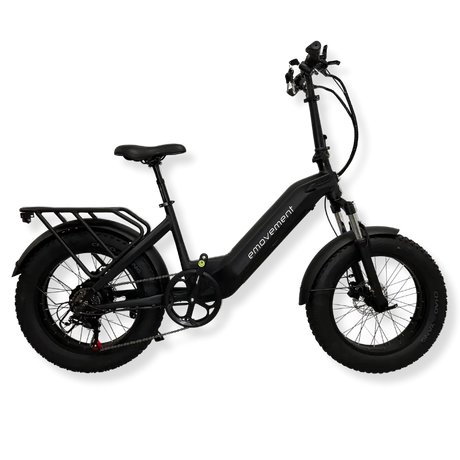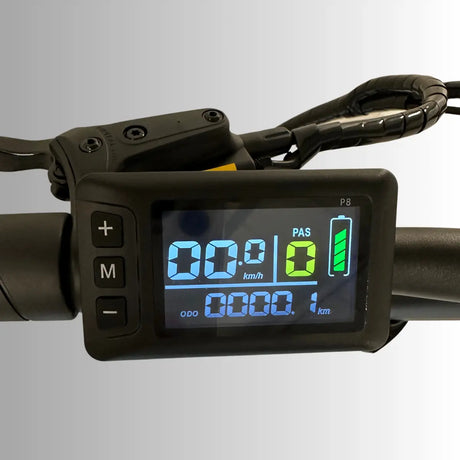Inside this Article:
- 1. Initial Purchase Costs
- 1.1 What Affects the Price of an eBike?
- 1.2. Price Range Analysis
- 1.3. Comparing Costs with Traditional Bikes
- 2. Ongoing Costs
- 2.2. Maintenance and Service Costs
- 2.3. Battery Replacement and Management
- 2.4. Energy Costs
- 2.5. Tyre Replacement Costs
- 3. Additional and Hidden Costs
- 4. Cost Saving Opportunities
- 5. Long-term Value and Resale
- 6. Conclusion
- 7. FAQs
- 7.1. What is the cheapest electric bike?
- 7.2. How long does an electric bike battery last?
- 7.3. Are there any hidden costs I should be aware of when buying an electric bike?
- 7.4. Can electric bikes be a good alternative for daily commuting?
- 7.5. How do I maximize the lifespan of my electric bike?
- 7.6 What are the charging costs of an electric bike?
As urban mobility shifts towards more sustainable options, electric bikes are emerging as a popular choice for both daily commuting and leisurely explorations across the UK. With their increasing popularity, it’s essential for potential buyers to fully understand the total cost of ownership which includes not only the purchase price but also ongoing operational expenses, such as charging costs.
Whether you’re a first-time buyer or looking to upgrade your current model, keep reading as we explain how much does an electric bike really cost. Here's everything you need to know about the financial aspects of owning an ebike in the UK.
1. Initial Purchase Costs
The initial cost of an electric bicycle is often the foremost priority for potential buyers when delving into the market rates.
What Affects the Price of an eBike?
Electric bike costs can vary widely, influenced by several key factors that potential buyers should consider before making a purchase. These factors affect the initial cost, long-term value, and performance of the e-bike:
I. Brand and Quality
High-end brands often command higher prices due to credibility, durability, and after-sales service. The build quality, which includes the materials used for the frame and components, also significantly impacts the price. Higher quality usually means higher costs but extended use and less frequent repairs.
Of course, with artificial inflation being at an all-time high, many brands simply charge high for their name and age.
(Not us! We’re proud to offer electric bikes at a price that’s the perfect balance between top-tier specs and affordability – no low-grade materials, no ridiculous profit margins)
II. Bike Type
The type of e-bike plays a crucial role in determining how much does it cost. Different categories include:
- Mountain eBikes: Designed for off-road use, these bikes are typically equipped with robust frames, powerful motors, and larger batteries. Prices for mountain e-bicycles can range from approximately £1,500 to over £5,000, depending on the sophistication of the technology and materials used.
- Road eBikes: Road e-bikes are built for speed and long distances on pavement, incorporating lightweight materials and streamlined designs. They generally start around £1,200 and can go up to £6,000 for high-end models with advanced components and ultralight materials.
- Hybrid eBikes: These bikes combine features suitable for both road and light off-road use and are generally priced mid-range, from about £1,000 to £3,000. Hybrid electric bikes offer a balance of performance and versatility, making them popular among casual riders and commuters
- Folding eBikes: Known for their convenience and portability, folding e-bikes often integrate complex engineering to allow easy folding and storage. These bikes usually cost between £1,000 and £3,000, with premium models priced higher due to innovative design solutions.
III. Battery and Motor Technology
More powerful motors and larger capacity batteries typically increase the cause because they provide longer range and better performance. Electric bikes with mid-drive motors also cost more because of the expensive nature of the electrical components and manufacturing process involved.
IV. Features and Technology
Additional features such as integrated GPS, theft protection systems, advanced display screens, and Bluetooth connectivity can also escalate the cost and its overall price. The more cutting-edge the technology, the higher the price.
V. Regulatory Compliance
Bikes that adhere to local regulations and safety standards may have additional design and manufacturing costs. Compliance with these standards often requires extra testing and certification, which can affect the overall price.

1.2. Price Range Analysis
eBikes are available at various price points to suit different budgets and needs in the UK market:
Entry-level Electric Bikes
Typically priced between £600 and £1,200, these bikes offer basic functionalities suitable for newcomers or those with limited needs. Entry-level bikes are the way to go if you are looking for a gentle introduction to electric biking.
Mid-Range Electric Bikes
Mid-range models are generally available from £1,200 to £2,500 for those willing to invest more for added performance. They come with better batteries, enhanced motors, and additional features like improved suspension and integrated tech.
High-End Electric Bikes
At the top end of the market, prices range from £2,500 to £6,000 or more. These premium models cater to enthusiasts and professionals, featuring cutting-edge technology , superior build quality, and the best available components for optimal performance and durability.
1.3. Comparing Costs with Traditional Bikes
Traditional bike costs can range from around £100 for a simple model up to £1,000 for a high-quality version, markedly less than most electric bikes. However, ebikes include advanced components such as motors and batteries, justifying their higher price points.
Though electric bicycles represent a higher upfront investment, the long-term benefits—like reduced public transport fares, lower fuel costs for car users, and the health and environmental benefits of cycling—can offset the initial cost. Additionally, the convenience and efficiency of electric bikes enhance their overall value, making them a compelling choice for many users in the UK.
2. Ongoing Costs
Once you've made the initial investment in an electric bicycle, understanding ongoing ebike costs is essential for managing your budget effectively. In this section, we’ll elaborate on regular expenses such as maintenance, battery management, and energy expenses:
2.2. Maintenance and Service Costs
Regular maintenance is essential for ensuring the longevity and optimal performance of your e-bike. However, it adds to an electric bike’s cost
Regular Maintenance and Service Needs
Like traditional bicycles, ebikes require routine checks and upkeep to ensure safe and efficient operation. This includes checking tyre pressure, adjusting brakes, lubricating gears, and making sure that all mechanical components are functioning properly. Additionally, e-bicycles require care for their electrical systems, such as the motor and display, which may involve firmware updates, checking connections , and proper motor alignment.
Cost Comparison with Non-Electric Bikes
Basic maintenance expenses for electric bikes are similar to those for traditional bikes, usually ranging from £50 to £100 per year. However, ebikes incur additional costs for maintaining electronic components. These can range from an extra £50 to £100 annually, depending on the bike's model and how intensively it is used. This makes the total maintenance and charge cost of an electric bike somewhat higher but still manageable due to its benefits.
2.3. Battery Replacement and Management
The battery is a core component of an e-bike, significantly impacting its performance and lifespan:
Electric bike batteries typically last 3 to 5 years, equating to about 500 to 1,000 charge cycles. Still, this can vary based on maintenance and usage patterns. Proper care, like avoiding extreme temperatures, not overcharging, and keeping the battery at least partially charged when stored, can extend its life.
Battery replacement costs can vary widely based on the type and capacity of the battery. In the UK, they generally range from £200 to £800. Investing in a high-quality battery and maintaining it carefully can help put off this expense and enhance the bike's performance and range.
2.4. Energy Costs
Managing the energy costs of operating an electric bicycle is another important consideration for owners:
How Much Does it Cost to Charge an Electric Bike?
The cost to charge an e-bike will depend on your area’s energy prices. An e-bike battery ranges from 250 Watts to 500 Watts. For instance, a typical electric bike with a 500 Wh battery costs about 10 pence to charge fully if the electricity rate is 20 pence per kWh. As a common rate in London, this calculation involves converting the battery capacity from watt-hours to kilowatt-hours (500 Wh is 0.5 kWh) and then multiplying by the cost per kilowatt-hour. Such low prices make e-biking an economically efficient option, especially when compared to the fuel expenses associated with automobiles.
Electricity rates can vary across different regions in the UK, affecting the overall charging costs slightly. For example, in the North of England where rates might be around 18 pence per kWh, the cost to charge the same battery would be about 9 pence. In contrast, in Scotland, where rates could be higher at 22 pence per kWh, it would cost approximately 11 pence. We recommend charging your bike during off-peak hours if you are on a variable electricity tariff to further reduce your bills. This strategic approach to charging enhances the appeal of e bikes as an economical and environmentally friendly transportation option.
Impact of Battery Capacity and Usage on Energy Costs
The capacity of the battery and the frequency of use directly affect energy costs. Larger batteries will cost more to charge, though the expense per charge cycle remains relatively low compared to other transportation methods such as driving. Regular use increases these expenses, but even frequent charging remains economical. We recommend using an electric bike charging cost calculator in the UK to help accurately estimate your specific energy prices. This allows for better budget management and cost-effectiveness.
2.5. Tyre Replacement Costs
Tyre wear and the need for replacement can vary significantly based on how frequently the bike is used and the terrain it encounters:
Tyre Replacement Frequency
Electric bike tyres need to be replaced when they show signs of significant wear, such as visible tread wear, sidewall damage, or frequent punctures. Due to their heavier weight and higher speeds, e-bike tyres may wear out faster than non-electric ones. Generally, they should be checked regularly but typically need to be replaced every 1,000 to 3,000 miles. More frequent replacements may be necessary for riders who travel on rough terrain with off-road bikes or carry heavy loads.
Cost of Tyres
Electric bike tyre replacement costs can range from £20 to £60 each in the UK, depending on the type and quality. Specialized e-bike tyres are at the higher end of this range since they are designed to handle the extra load and provide better grip and puncture resistance.
3. Additional and Hidden Costs
Investing in an e-bicycle involves considering not only the purchase price but also the additional and, sometimes, hidden costs that come with it. These can significantly affect your budget , encompassing everything from essential accessories to insurance and security measures:
3.1. Accessories and Upgrades
When you accessorize and upgrade your ebike, you can significantly enhance its functionality and your overall riding experience:
Essential Accessories for E-Bikes
To ensure safety and functionality, basic accessories such as helmets , lights, and locks are indispensable. High-visibility clothing is also crucial for safety, especially in poor lighting conditions. If you’re interested in added comfort or enhanced performance, you might consider investing in panniers for storage, mudguards for wet conditions, and upgraded seats for longer rides.
Costs of Popular Upgrades
Depending on your needs, you might choose to invest in upgrades that improve performance or comfort. For example, upgrading to a higher-quality battery can increase range and reliability, with costs typically varying from £200 to £800. Similarly, high-performance tyres designed for better traction and durability might cost between £30 to £100 each, based on brand and specifications. These upgrades can significantly improve your biking experience and are often worth the investment.
3.2. Insurance and Security
Given the significant investment involved in purchasing an e-bike, ensuring it is adequately insured and secured is paramount:
Due to their value and appeal, electric bikes are often targets for theft. Insurance can provide peace of mind by protecting against theft, damage, and in some cases, breakdowns. It’s a small additional cost that guards against potentially significant losses. The right insurance policy provides coverage for accidental damage, liability, and theft, which can be crucial if you frequently ride in busy urban areas.
Average Costs and Recommended Providers
E-bike insurance in the UK can vary, typically costing between £5 to £15 per month. This variance depends on the bike’s value and the chosen coverage level. Providers such as Bikmo, CycleGuard, and ETA offer comprehensive electric bike insurance plans tailored to different needs and budgets. When selecting a provider, it's important to compare policies to ensure they cover all potential risks specific to e-bicycle usage.
Security Measures and Their Costs
Beyond insurance, physical security measures are important. A robust bike lock is an essential purchase, costing anywhere from £20 to £100. For additional security, particularly in high-risk areas, investing in a GPS tracker can be wise. These devices help in tracking the bike's location in real-time if stolen and vary in price from £50 to £150. Such devices deter theft and aid in the recovery of the bike, potentially saving the owner from a total loss. Implementing physical security measures acts as a first line of defence to discourage potential thieves and guarantee your investment remains safe.
4. Cost Saving Opportunities
Exploring ways to save on the costs of ebikes can make them more accessible and appealing. Now that you know how much do e-bikes cost, let’s consider various opportunities to reduce expenses:
4.1. Government Incentives and Subsidies
Governments around the world are increasingly offering incentives to encourage the adoption of ebikes as part of their green transport initiatives:
Incentives for purchasing e-bikes vary by country and can significantly offset the initial cost. For example, in France, buyers can receive up to €200 in subsidies. In the UK, the Cycle to Work scheme allows employees to buy electric bicycles tax-free, saving up to 40% of the cost. Other countries might offer tax rebates, purchase grants, and subsidies for trading in old bikes for new electric models, making e-bikes more affordable and appealing.
To qualify for these incentives, purchasers typically need to buy from approved suppliers and select bikes that meet certain environmental standards. This helps ensure that the benefits of such programs are maximized. Additionally, applying through designated government schemes or programs is often required before making a purchase. It's important to research local regulations and available benefits in your region to take full advantage of these opportunities.
4.2. Second-Hand Market
Inspecting the second-hand market for an e-bike can provide significant savings. However, it's important to weigh both the advantages and disadvantages to ensure you make a well-informed decision. In this section, we’ll also provide some tips on how to pick the right second-hand electric bike for yourself.
Buying a used electric bicycle offers several advantages that can make it an appealing option for budget and environmentally-conscious consumers. The most compelling benefit is the potential for considerable cost savings. Second-hand ebikes can be much cheaper than their brand-new counterparts.
Purchasing a used electric cycle is also less wasteful aligning with eco-friendly practices. And unlike new bikes which may have waiting periods due to high demand, used bikes are readily available for purchase and use.
However, while there are advantages, there are also some drawbacks to purchasing a used e-bike that potential buyers should take into account.
Battery life concerns are among the most significant concern in buying a second hand ebike. A used bike may come with a battery that has diminished capacity and will require an expensive replacement sooner. Used e-bicycles might also have significant wear and tear, which can affect performance and safety. Older models may lack the latest features and improvements found in newer bikes, such as enhanced motor efficiency, better ergonomics, and more modern user interfaces.
Most used electric bikes will not come with a manufacturer warranty, meaning any repairs or replacements will be out-of-pocket expenses.
4.3. DIY Electric Bike Kits
If you wish to enter the e-bike world without purchasing a brand-new bike, DIY electric bike kits are the way to go. This approach can be particularly appealing to those who already have a high-quality bicycle and wish to extend its functionality.
DIY e-bike conversion kits are designed to transform an ordinary bike into an electric one by adding a motor, battery, and controller. These kits are available for various types of bicycles (such as road, mountain, and hybrid bikes) and are tailored to suit different riding styles and needs. The kit typically includes all the essential components: a motor unit (which can be mounted on the front or rear wheel), a battery pack (often attachable to the frame or seat post), a throttle, and a controller to manage power output.
Cost Comparison with Buying New
The financial aspect of DIY kits can be particularly attractive:
The price of conversion kits ranges from about £200 to £1,000, depending on the system's complexity and the components' quality. This range makes it a more affordable option than new e-bicycles, which generally start at around £1,000 and can go much higher for advanced models.
For those who already own a good quality bike, converting it with a DIY kit can significantly reduce the overall investment needed to go electric. It allows cyclists to retain a well-fitting frame and a familiar setup while adding the benefit of motorized assistance. Riders have the choice to customize the bike to specific needs and preferences, something that off-the-shelf ebikes may not always offer. Plus, you can choose how much you want to spend based on the kit's features and the quality of components like the battery's capacity and the motor's power.

5. Long-term Value and Resale
When investing in an electric bike, it's important to consider not just the initial expenses and maintenance, but also the long-term value and potential for resale. Understanding the factors that affect depreciation and staying informed about resale market trends can help you preserve the value of your e-bike over time.
5.1. Depreciation Factors
Like any vehicle, electric bikes depreciate over time. Several factors influence how quickly and significantly they lose value.
What Affects Electric Bike Depreciation
Understanding what affects the depreciation of electric bicycles is essential for both buyers and sellers in the e-bike market:
- Brand and Model Reputation: Well-known brands and models that are highly regarded tend to hold their value better. This is because of their perceived reliability and demand.
- Battery Condition: Since the battery is a critical component, its health significantly affects the bike's overall value. A well-maintained battery can slow depreciation.
- Technological Advances: Rapid advancements in e-bike technology can make older models obsolete more quickly, accelerating depreciation.
- Physical Condition: Bikes that are well-cared-for, with minimal wear and tear, depreciate less rapidly than those that are heavily used or damaged.
6. Conclusion
Electric bikes in the UK can vary significantly in price, with options ranging from £600 for entry-level models to over £6,000 for high-end versions. The ongoing expenses for maintenance, energy, and occasional battery replacements are relatively low, but additional expenses such as accessories, insurance, and security measures should be considered. Despite the initial cost, the long-term savings on transportation, environmental benefits and the convenience of electric assistance, make electric bikes a valuable investment.
7. FAQs
1. Are there any hidden costs I should be aware of when buying an electric bike?
Besides the initial purchase price, potential hidden costs generally include charging costs, battery replacement, regular maintenance, and necessary accessories like helmets and locks. Insurance and enhanced security measures can also add to the total cost of ownership.
2. Can electric bikes be a good alternative for daily commuting?
Electric bikes are an excellent alternative for daily commuting. They offer a cost-effective, environmentally friendly, and efficient way to navigate urban and suburban areas, reducing reliance on cars and public transport.
3. How do I maximize the lifespan of my electric bike?
To maximize the lifespan of your e-bike, perform regular maintenance such as checking tyre pressure, adjusting brakes, and lubricating the chain. Properly care for the battery by avoiding extreme temperatures and overcharging. Additionally, store your bike in a safe, dry place to protect it from the elements.
4 What are the charging costs of an electric bike?
Generally, charging an e-bike is quite cost-effective in the UK. For example, fully charging a 500Wh battery typically costs about 14 pence, based on the average UK electricity rate of about 28 pence per kWh. Note that this calculation assumes a complete charge cycle from 0% to 100%.























































































